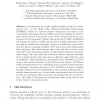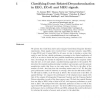115 search results - page 9 / 23 » A Framework of Adaptive Brain Computer Interfaces |
JMLR
2010
13 years 6 months ago
2010
Traditional analysis methods for single-trial classification of electro-encephalography (EEG) focus on two types of paradigms: phase-locked methods, in which the amplitude of the...
ETVC
2008
13 years 9 months ago
2008
Computational anatomy is an emerging discipline that aims at analyzing and modeling the individual anatomy of organs and their biological variability across a population. The goal ...
ICCS
2009
Springer
14 years 2 months ago
2009
Springer
Abstract. A framework for a fully implicit solution method is implemented into (1) the High Order Methods Modeling Environment (HOMME), which is a spectral element dynamical core o...
DAGM
2006
Springer
13 years 11 months ago
2006
Springer
We present the results from three motor-imagery-based Brain-Computer Interface experiments. Brain signals were recorded from 8 untrained subjects using EEG, 4 using ECoG and 10 us...
LREC
2010
13 years 9 months ago
2010
We present Witchcraft, an open-source framework for the evaluation of prediction models for spoken dialogue systems based on interaction logs and audio recordings. The use of Witc...


